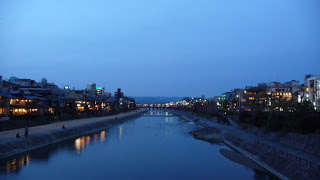The Kamogawa, at night, looking north. Learned an interesting thing about orienting yourself within the (already very sensible) street grid of Kyoto: you always have mountains on three sides, and the ’empty’ side is south.
The bright lights on the west bank are the outward-facing manifestation of the much-beloved and little-penetrated Pontocho district.
Maybe it’s unfair to say ‘little-penetrated’, because the single alley that defines the neighborhood, making it distinct from the parallel and much seedier Kiyamachi, gets tons of foot traffic. That traffic surely concentrates on the accessible options though – the restaurants with bright frontage, vegetable displays, laminated menus, and greeters. It surely doesn’t enter the places with white lanterns and no windows – those are invitation only. And not much of it ducks into the narrow alleys with little signs peeking out at odd intervals. That was our mission tonight.
If anything, Kyona was distressingly ordinary – a distressed interior and confused mama, while those yellowed bricks and well-used grill made me think of the uber-high-end Hirosaku in Shinbashi. There were two other customers, very much in the company-man mold, one of whom did a lot of showing off about his English ability and his ‘private jet in New York’. After a while, an aging and hardened hostess came in to wait for her escort.
The most interesting element of the interior was certainly this sake warmer, stocked with the pretty-good Eikun. Old gadgets like this are fun when they’re still in use, and the ability to control the temperature is neat. There must be some quality effects from keeping the big reservoir on top heated to drinking temperature all the time though. Seems like it probably sacrifices flavor for convenience since stuff must evaporate even if it’s enclosed. I wonder if that’s what made it taste so mellow.
I don’t wonder at all about the food – it was good. The mixed shellfish and vegetables in vinegar miso was lovely and sharp, while the boiled octopus was just at the right point between chewy and over-softened. After that it was all eel; the uzaku is a summer specialty that I was surprised to see on the menu – grilled eel and cucumbers in sweet vinegar – and it was even more surprising that mama grumbled something about the food taking time before going off to barbeque the eel from scratch. And the Hachiman-maki was surprising too, because it’s called Yahata-maki here (still 八幡巻 though, and I prefer saying Hachiman because I live near a famous Hachiman shrine), and is made the original way with eel wrapped around the boiled burdock roots rather than the now-more-common beef.

